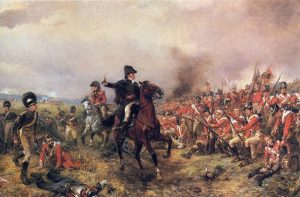Create a Plan of Action
Continuing my series on how you overcome significant setbacks- and having hit a crunch point- how you get going again. It is all too easy to, either get stuck in despair or impulsively try anything to retrieve a bad situation. Neither works.
You have this lovely shiny goal that you want to achieve. To do so, it is critical that you create a plan of action. Think of it like a military campaign. You have a battle to fight. The first thing is to think of a strategy – a plan of action designed to achieve your long-term or overall aim just as generals did (please ignore the bad examples).
Being strategic rather than impulsive is a real plan of action
However passionate you feel about your goal- without strategy your impulse to succeed will end in failure. You need to have an overall view of how you want to achieve your goal and strategic thinking is crucial for success.

One of the most famous battles of all time is The Battle of Waterloo, led in most part by the Duke of Wellington. Unless you have studied this period of history, you may not know that Wellington’s army was a mish mash of nationalities with a lot of young and inexperienced soldiers. One of Wellington’s strategies was to create battalions of mixed nationalities, led by his most experienced soldiers- recalled from other battles in Spain and America. He did not want the fighting men to feel they “had to be British” so he wore the cockades of all the Allies in his iconic two cornered hat and forbade the singing of ‘Rule Britannia’ at concerts. He wanted the troops to think of themselves as an international force. Wellington knew he was outnumbered by Napoleon’s forces until the supporting Prussian army led by Blucher could join him; his plan of action was to buy time until support arrived. Wellington had to employ a strategic deployment of troops at identified locations and hold the high ground to defeat Napoleon. He won the battle because he out-thought Napoleon strategically, held his nerve and focused his army’s efforts.
All the business of war, and indeed all the business of life, is to endeavour to find out what you don’t know by what you do; that’s what I call ‘guessing what was at the other side of the hill’.
Wellington, Duke of Wellesley
What tactics are needed in your plan of action?
In military terms tactics – (canon, infantry, cavalry) can cover what type of army to deploy, where and how armed. In a business case, what marketing strategies can you use, delivered via traditional, 1-2-1, website, social media methods etc.
Your tactics will be influenced by reach, impact, cost and your own level of knowledge. They need to align with your strategy. Your plan of action knows your end goal and works back from there. Each strategy is linked to a variety of tactics; you cannot have one without the other. Your strategy has the element of “Why” you are doing this- your tactics are the “How” you deliver each step of your plan of action.
 Under each of these tactics you then need to extract the tasks to be undertaken. Map all these out with an end date for accomplishment (not set in stone but something to aim for). Identify the most critical elements and ensure their completion is given priority (conduct a critical path analysis for your plan of action).
Under each of these tactics you then need to extract the tasks to be undertaken. Map all these out with an end date for accomplishment (not set in stone but something to aim for). Identify the most critical elements and ensure their completion is given priority (conduct a critical path analysis for your plan of action).
Review how you are doing on at least a monthly basis. Anything that is not working – ditch. Do not hang on hoping it will work- hope has no place in strategy or tactics. Anything that is working – do more of, rinse, repeat and compound the successful.
Without a plan of action your brave new start will either come crashing down round your ears or fizzle out. Recovering from a significant downturn in business or a personal crisis is an emotional situation. A plan of action gives you focus and a route forward. Next week I’ll look at how you track your progress, assess and adjust to ensure you are following the right path with your tactics and strategy.

